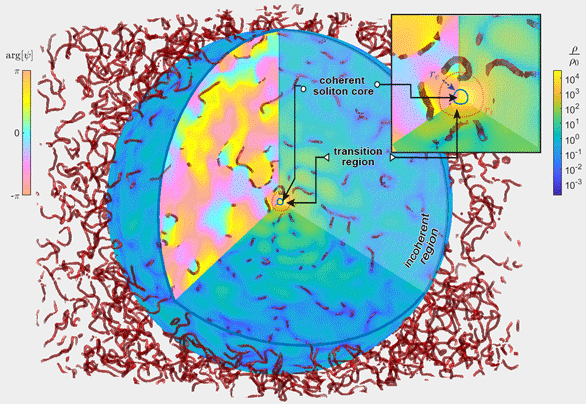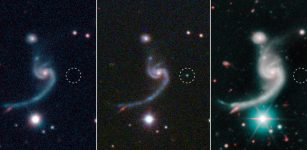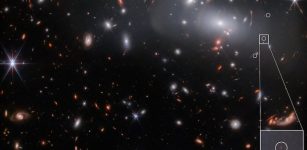Research Sheds Light On New Model Of Cosmological Dark Matter
Eddie Gonzales Jr. – MessageToEagle.com – Newcastle University researchers used insights gained from the study of ultracold atomic Bose Einstein condensates to analyze the behavior of fuzzy dark matter, a new model for cosmological dark matter that has recently drawn the attention of cosmologists.
The center of a fuzzy dark matter halo, labelled “coherent soliton core” in the above picture, is physically indistinguishable from a coherent BEC like those created in typical cold atomic systems, but extending over thousands of light years. With the inclusion of a small transition region, the rest of the halo is incoherent due to a tangle of quantum vortices which criss-cross the halo’s volume outside the vortex-free core. The vortex tangle is time dependent but the overall vorticity it creates remains constant in time. Credit: Dr. Gary Liu, Newcastle University
They found that the physical state of the core of fuzzy dark matter halos, the gravitationally bound structures in which galaxies like our own are thought to form, is the same as that of Bose-Einstein condensates (BEC) formed in laboratory atomic traps.
The interdisciplinary team also found that the fuzzy dark matter surrounding the halo cores is in a turbulent state, with vortices and fluctuations that inhibit coherence across the entire halo. These properties distinguish fuzzy dark matter form the more widely accepted model of cold dark matter in which there are no coherent features and no quantum vortices
The scientists demonstrated that the centers of dark mater halos in this new fuzzy dark matter model are practically giant BECs, extending not over millionths of meters (micrometers) as in typical cold atomic systems, but over thousands of light years (equivalent to tens of million billion Kilometers), encompassing the centers of galaxies, and exhibiting a property characteristic of quantum systems and BECs called coherence.
The study also describes the internal motions of the outer halos and the kinetic energy of the dark matter there, which gives rise to an intricate tangle of the quantum vortices with characteristic density profiles in their cores.
Their findings have been published in the journal Monthly Notices of the Royal Astronomical Society.
Meeting of two disciplines
Cosmology deals with the very large scales in nature, from the realms of galaxies and galaxy clusters to the whole observable universe. Cosmologists make observations of the universe, obviously being unable to perform experiments, and the main natural force they are concerned with is gravity. Such observations have revealed that most of the matter that makes up the cosmos is unlike that which makes up humans, planets and stars, and is composed of an unknown substance named, for lack of a better word, dark matter.
Credit: Newcastle University
Ultracold atomic physics, on the other hand, describes the behavior of clouds of atoms, such as rubidium, potassium and sodium gasses, typically at millionths of a degree above absolute zero in laboratories around the world, and examines phenomena that reveal the quantum nature of matter.
The study brought these two disciplines together, led by Newcastle University’s Dr. Gerasimos Rigopoulos and Professor Nick Proukakis, theorists in cosmology and ultracold atomic physics respectively. The team also included research fellow Dr. I-Kang (Gary) Liu who recently completed his Marie Curie fellowship on the topic, Dr. Alex Soto, and Ph.D. student Milos Indjin.
Dr. Rigopoulos, senior lecturer in applied mathematics, said, “Fuzzy dark matter has been studied already for a few years now by cosmologists, but our work has applied concepts from the study of BEC dynamics which has been around for much longer. We now understand that there are specific similarities with BECs and the ultimate goal is to use this knowledge to devise ways for better testing this new and exciting model observationally.”
See also:
Attempting To Catch Dark Matter In A Basement
“I have always kept an open eye for interdisciplinary approaches in physics and this has been a perfect problem to tackle from such an angle. Establishing a common language took some time but we could see from the beginning, even as we conceived this project, that there were rewards to be reaped when you go out of your comfort zone and try to see things from a new perspective. I think our perseverance paid off and we have only scratched the surface of what such a collaboration can do.”
Professor Proukakis, professor of quantum physics and a strong advocate of universal features of such forms of quantum coherence, added, “It is fantastic to see yet another plausible realization of a system exhibiting Bose-Einstein condensation: this is incredible to see, as we are now dealing with such a huge system beyond the imagination of those first studying this phenomenon in controlled laboratory settings.”
“Although creating a potential mimicking gravitational attraction in controlled laboratory settings remains challenging/unknown in three-dimensional systems, analogous initially seemingly impossible challenges have eventually been met in such experimental systems. The mere prospect, even if not highly likely, of future possibilities of creating laboratory settings mimicking certain aspects of matter distribution in the universe is exciting in its own right.”
“Moreover, even as a theoretical playground, it is fantastic to have a new system to model, trying out extensive expertise gained from laboratory condensates, and hoping for future observational tests in cosmology.”
Future research will focus on possible ways to observe such features of fuzzy dark matter, thus placing this model under more detailed observational scrutiny.
The scientists are preparing a range of follow-up publications, having already completed a study showing the theoretical similarity of the equations governing the fuzzy dark matter model to those used in studying how Bose-Einstein condensation develops in the lab as atomic gasses are cooled to near absolute zero.
They are currently using insights from established theories, devised to describe cold atoms, to unify the conventional cold dark matter and the new fuzzy dark matter models mathematically, while also looking into the implications and, in the longer-term, observational probes of such findings.
Written by Eddie Gonzales Jr. MessageToEagle.com Staff











